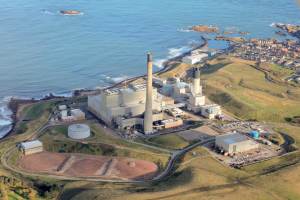“For us, climate change…is a threat that we want to act on.”


 “We’re not aligning with skeptics.” So claimed Ben van Beurden, CEO of Royal Dutch Shell, last week
“We’re not aligning with skeptics.” So claimed Ben van Beurden, CEO of Royal Dutch Shell, last week
in an interview with Steven Mufson of The Washington Post.
“The real challenge is not so much how do we accelerate renewables but more about how do we decarbonize the system we have. How do we take coal out and replace it with gas? That’s half the CO2 already. How do we fit carbon capture and storage on electricity generation and bring the carbon emissions of a third of the energy system down by 30 percent?”

The image to the left is of what could be the world’s first operational commercial gas carbon capture and storage (CCS) project, located at Aberdeenshire, Scotland. This Shell facility, called Peterhead, is in the initial Front End Engineering and Design (FEED) phase. The goal is to send the captured CO2 from the existing, combined-cycle gas turbine power station to the depleted Goldeneye gas field under the North Sea for storage. Goldeneye is about 102 km (more than 60 mi.) off the Scottish coast. Peterhead is expected to demonstrate a carbon emissions capture rate of around 90% of the emissions from natural gas burned there for power. An estimated 10M tons of CO2 are expected to be stored at Goldeneye over a 10-year period.
This project is co-winner of a competition sponsored by the British government which offered “£1 billion in capital funding, together with additional operational funding through the UK Electricity Market Reforms, to support the design, construction and operation of the UK’s first commercial-scale CSS projects.” 4 projects were shortlisted 2 years ago, and 2 finalists received funding for the initial, FEED phase.
The other project, The White Rose CCS Project, is in Yorkshire, England. This project, also in FEED stage, intends to capture around 90% of the CO2 from a new super-efficient coal-fired power station in North Yorkshire for transport to storage in a saline rock formation beneath the North Sea. (For more on these two projects, click here.)
Shell, which is currently developing oil sands in western Canada, has a CCS project underway there, estimated to be able to capture 1M tons of CO2 annually from on-site operations.
A 4-minute video about CSS outlines the technology, science and process. Click here.
Incidentally, Shell is tracking its GHGs (greenhouse gas emissions) annually. 73M tons of CO2 were generated in 2013 throughout its global facilities. This total GHG was slightly higher than 2012. From various reports, Shell uses an internal price of $40/ton for CO2 emissions when looking at possible new projects, a number nearly 6 times the current price for pollution rights in the EU’s carbon market. This cost of carbon can influence the company’s decision to invest in a potential project or not.
 Shell’s controversial $4.5B effort to drill in the Alaskan Artic has engendered much rhetoric from the environmental activists who say it demonstrates corporate cynicism when talking up its environmental agenda. But, van Beurden is among many to say the demand for energy won’t be satisfied by renewables in the foreseeable future. Currently about 1% of the world’s need is being supplied by wind and solar. So, that puts him back to his carbon capture calculus.
Shell’s controversial $4.5B effort to drill in the Alaskan Artic has engendered much rhetoric from the environmental activists who say it demonstrates corporate cynicism when talking up its environmental agenda. But, van Beurden is among many to say the demand for energy won’t be satisfied by renewables in the foreseeable future. Currently about 1% of the world’s need is being supplied by wind and solar. So, that puts him back to his carbon capture calculus.
P.S. If you’ve learned something interesting in this post, please be sure to Like it on the DW-GREEN Associates Facebook page.